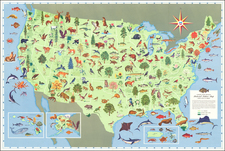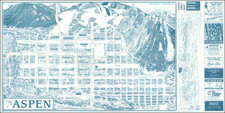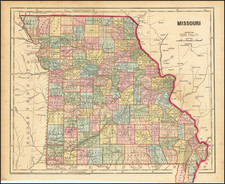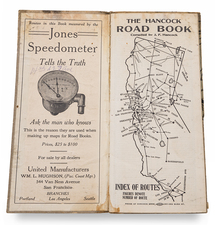Map of the Great Central Overland Short Line Route, Via Rock Island
Alta California Railroad Printing House Imprint -- Shows The Cherokee Neutral Lands at the Height of Controversy
Rare early Rock Island Railroad Transatlantic Railroad map, printed the Alta California Railroad Printing House of San Francisco in 1870, a very early effort to promote traffic on the Rock Island using the Transcontinental Railroad.
The present map was issued to capitalize on the recently opened Central Pacific Rail Road line to California. The map covers the central swath of the United States from Coast to Coast, higlighting the lines of the Chicago & Rock Island Railroad from Chicago to San Francisco in May 1870, one year after the driving of the ceremonial Golden Spike on May 19, 1869 opened rail traffic across the nation.
The Route of the Central Pacific is shown crossing the country, along with the proposed Kansas Pacific Railway. Further west, the Wagon Road from Los Angeles to Salt Lake can been seen, along with the Old Overland Mail Route.
The printer, the "Alta California Railroad Printing House," would seem to be nearly unique imprint. While the Alta California Printing House was active from 1867 onward, we find no company with the name Alta California Railroad Printing House.
Of topical interest, the map is also one of the few contemporary maps to show the so called Cherokee Neutral Lands, just as they were becoming the center of political controversy and armed conflict.
Cherokee Neutral Lands
Of further note is the large section land in southeast Kansas described as Cherokee Neutral Lands. Originally called the Osage Neutral Lands, the tract of land is located in the southeast corner of Kansas, and includes all of Cherokee County, most of Crawford County and a 6 mile strip of the southern part of Bourbon County.
First described in the treaty with the Osages in 1825, the area was to be set aside as a neutral zoner between the Osage tribe and white settlers, with neither Native Americans nor White settlers allowed to claim land. Article 2 of 1835 Cherokee Treaty at New Echota, Georgia noted that not enough land was set aside for the Cherokee nation, and provided for the conveyance to the Cherokees of the neutral lands, which were described therein as "the tract of land situated between the west line of the State of Missouri and the Osage reservation, beginning at the southeast corner of the same and runs north along the east line of the Osage lands 50 miles, to the northeast corner thereof; and thence to the west line of the State of Missouri; thence with said line south 50 miles; thence west to the place of beginning—estimated to contain 800,000 acres of land."
From 1835 onward, the tract became commonly known as the Cherokee Neutral Land. As was typically the case, white settlers did arrive.
On July 19, 1866, a treaty was concluded between the Cherokees and the United States, with article 17 providing that "The Cherokee nation hereby cedes, in trust, to the United States the tract of land in the State of Kansas which was sold to the Cherokees by the United States under the provisions of the second article of the treaty of 1835, and also that strip of land ceded to the nation by the fourth article of said treaty, which is included in the State of Kansas; and the Cherokees consent that said lands may be included in the limits and jurisdiction of the said state. The lands herein ceded shall be surveyed as the public lands of the United States are surveyed, under the direction of the commissioner of the general land office, and shall be appraised by two disinterested persons. . . . And the secretary of the interior shall, from time to time, as such surveys and appraisements are approved by him, after due advertisements for sealed bids, sell such lands to the highest bidders for cash, in parcels not exceeding 160 acres, and at not less than the appraised value. . . . Provided, that nothing in this article shall prevent the secretary of the interior from selling the whole of said Neutral Lands in a body to any responsible party, for cash, for a sum not less than $800,000."
The last provision was amended to read "that nothing in this article shall prevent the secretary of the interior from selling the whole of said lands not occupied by actual settlers at the date of the ratification of the treaty, not exceeding 160 acres to each person entitled to preëmption under the preëmption laws of the United States, in a body, to any responsible party, for cash, for a sum not less than one dollar per acre."
On Aug. 30, 1866, James Harlan, then secretary of the interior, sold the lands to the American Emigrant company. Two days later Mr. Harlan was succeeded by Orville H. Browning, who set aside the contract with the American Emigrant company on an opinion of the United States attorney-general that it was void because made on time and not for cash as the treaty stipulated. The settlers on the tract then demanded of Senator Pomeroy and Congressman Clarke that they use their influence to prevent another sale of the land. Both made promises, but in spite of that fact, on Oct. 9, 1867, Browning sold the land to his brother-in-law, James F. Joy, representing the Missouri River, Fort Scott & Gulf railroad. In March, 1868, the settlers made a demand for the right to purchase their holdings at the lawful price of public lands, and everywhere the validity of Joy's title to the lands was questioned. The American Emigrant company had not relinquished its claim and the settlers were alarmed at the prospects of long and tedious litigation before their titles could be assured. Trouble on this score was averted, however, by a supplemental treaty on April 27, 1868, "to enable the secretary of the interior to collect the proceeds of the sales of said lands and invest the same for the benefit of said Indians, and for the purpose of preventing litigation and of harmonizing the conflicting interests of the said American Emigrant company and of the said James F. Joy."
Technically, the treaty set aside the Joy sale, but authorized the assignment of the American Emigrant company's interests to Joy. Eugene F. Ware says: "This was necessary so as to scoop in the land occupied in the meantime by about 3,000 people under the public land law. The law gave a homestead on five years' occupation, but service in the army was counted in, and the soldier who had served three years got title in two years, but with the right to buy the land at $1.25 per acre. The 'treaty' ratified by the senate cut off these rights from all settlers coming in after July 19, 1866."
The supplemental treaty was ratified on June 6, 1868, when the interests of the American Emigrant company were assigned to James F. Joy, and four days later the treaty was proclaimed by the president. On December 18, 1868, notice was given to all persons "who had settled and continued to live on the lands between August 11, 1866, and June 10, 1868, that they might make entry of the lands before a certain time, and thus prevent the sale of the lands to other purchasers."
The survey of the railroad was commenced early in 1869, at which time trouble commenced. The settlers organized the "Land League," later known as the "Neutral Land Home-protecting Corps," to resist the encroachments of a corporation under what they believed to be an illegal sale of the public lands. At first, the principal object of the organization was to keep a delegate in Washington to look after the interests of the settlers, but as the railroad company became more aggressive in prosecuting what it conceived to be its legal rights, many acts of violence were committed in the name of the "League." A land office established at Baxter Springs by Joy was raided in February, 1869, and in April, when J. W. Davis attempted to open a land office for the railroad company at Columbus, he was given notice to leave the town—a mandate he lost no time obeying. By the last of May the situation had become so threatening that Gov. Harvey issued a proclamation enjoining the people to commit no unlawful acts, and asked Gen. Schofield to send a detachment of United States troops into the Neutral Lands to preserve order. Troops accordingly were sent into Crawford and Cherokee counties on June 10, 1869.
In 1870, the House of Representatives appointed a committee, which recommended that U.S. troops be kept there until the question was settled. Notwithstanding their presence, the anti-Joy people burned the office of the Girard Press on July 15, 1871. This paper was edited by Dr. Warner, who had been employed by Joy to publish it in the support of his claim.
In the meantime two suits had been filed in the Federal courts—one against a settler named Holden and the other against Dr. Warner, with the understanding that the title to the lands should be settled by the decision in the two cases. In May, 1870, the circuit court decided in favor of Joy. The decision was appealed to the United States Supreme Court, which affirmed the circuit court decision in November, 1872. The settlers then bought their lands through Joy, and in February, 1873, the troops were withdrawn.
Rarity
OCLC locates 1 example of an 1871 edition of the map (British Library).












![[ Missouri named State of Jefferson ] Etats-Unis par A.M. Perrot](https://storage.googleapis.com/raremaps/img/small/99019.jpg)

![(Southern California Aerial Photographs) [Collection of 9 Aerial Photographs of San Fernando Valley, Van Nuys, and Burbank]](https://storage.googleapis.com/raremaps/img/small/94783.jpg)

